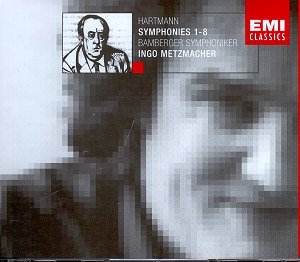This is not the first complete cycle of the Hartmann
symphonies. That honour rests with Wergo who issued them on four
CDs in 1989. Before that the Wergo recordings had appeared in
an LP boxed set in 1980. The CDs were designated AAD with the
recordings being studio tapes from Bavarian Radio variously conducted
by Macal, Rieger, Leitner and predominantly Kubelik. The EMI set
derives from full digital recordings made by one orchestra and
conductor. Interestingly Bavarian Radio are behind the cycle but
this time the Bamberg orchestra is used rather than Bavarian Radio
forces.
If you do not know Hartmann's symphonies then
you need to think in terms of Mahlerís Sixth filtered through
Berg and the Stravinsky of Oedipus Rex; maybe the Symphony
of Psalms.
The phantasmagorical First Symphony is
greatly enhanced in its cataclysmic despairing impact by the superb
contralto of Cornelia Kallisch who enunciates each word of the
Whitman poems with rare intelligence and accuracy. Comparing the
Rieger version on Wergo we encounter the very best of analogue
technology with spot-lit microphone placement of considerable
power. Doris Soffel is in much the same league as Kallisch but
is more closely recorded. It has to be said that even this close-up
positioning does no disservice to Soffel's voice.
The Third Symphony sounds more strikingly
powerful in the Wergo recording (conducted by Leitner) but closer
examination prompts a recommendation for the EMI whose wide dynamic
range from whispered Bachian cantabile to clamorous protest in
the massive adagio is rendered superbly by the new digital recording.
After the 35 minutes of the Third Symphony hearing
the quarter hour Second Symphony in all its glowing luminosity
and with its references to the sinister woodwind writing in the
Rite of Spring, is almost a relaxation. While the
EMI lacks the concert depth and immediacy of the Wergo it is a
more natural balance. If you want spectacular rather than natural
then you opt for Wergo but dynamic range is rendered with greater
fidelity by EMI.
The half hour Fourth Symphony is intensely
put across by Kubelik who on Wergo also conducts numbers 5 and
6 and the Gesangs-Szene the latter not included in the
Metzmacher. EMI stick to the symphonies and nothing but the symphonies.
Metzmacher is in not quite the same league of intensity as Kubelik
but the recording has plenty of heft as a comparison of the two
versions of the allegro di molto second movement shows.
When it comes to the bubbly Pulcinella-accented
Fifth Symphony with its scherzo looking back seventeen
years to the finale of Shostakovich's First Piano Concerto, honours
are divided pretty equally. Close-up recording placement is typical
of the whole Wergo cycle making a really immediate impact on the
listener.
The Sixth Symphony is one of the most
powerful symphonic utterances of the 1950s. A hefty adagio
is followed by a manic Toccata variata which runs out of
hand even faster with Metzmacher than with Kubelik.
From the Sixth Symphony onwards all the symphonies
were in two movements. The Seventh was first performed
in 1959 having been written over the previous three years. It
is soured, Bergian, the zenith of clarity and the avoidance of
orchestral congestion. Metzmacher has the usual advantage of totally
silent surfaces whereas Macal (in an unaccustomed role in 20th
century repertoire) labours with the analogue hiss which seems
to be slightly more noticeable in this case. The EMI bands the
second section (scherzoso virtuoso) of the last movement
separately where the Wergo does not.
The Eighth is Hartmann's most extreme
symphony. It is soured in the avant-garde episodic kaleidoscopic
stream. Brilliantly recorded in the Wergo version, the players
put it across with an almost death-defying singleness of purpose;
so do Metzmacher and his orchestra. Metzmacher makes more of the
poetry of the work - and there is poetry there.
The first six symphonies each have their origins
in works written during the Nazi period 1933-45 and then withdrawn.
Thus No. 1 draws on Symphonic Fragment (1935-36), No. 2
on the slow movement of the 'symphonic suite' Vita Nova,
No. 3 from parts of the Klagesang (1944) and Tragica
(1940-43) symphonies, No. 4 from a concerto for strings and soprano
(1938), No. 5 from a 1932 trumpet concerto and No. 6 from the
symphony L'Oeuvre (1937-38). It would be good to track
down and record all these original works (Koch have recorded the
Tragica) and try to understand why Hartmann discarded them.
They are documents of an appalling era but one whose reflection
of the contemporaneous effect on Hartmann is likely to be stimulating
telling us, from our position of comparative comfort, something
about being swept up in the hectoring horror of the times.
The words of the First Symphony (the only one
with a vocal element) are provided in German, English and French
in the booklet. The compact notes are by Andreas Jachinski.
The Wergo set still sounds pretty spectacular
with close-up miking and potent dynamics. Each of those radio
tapes was an event and you can feel that. The Metzmacher versions
are good and better but, swings and roundabouts allowing, the
Wergo is more likely to deliver a memory-etched experience than
the EMI. The Wergo is not as well documented as the EMI and of
course you have to put up with good analogue FM sound. This means
background hiss which many will want to avoid. For those who go
for the Metzmacher they are unlikely to be disappointed. These
EMI versions are likely to be the library standards for at least
the next decade. On this basis I can happily recommend this set
and would only propose the Wergo to those who want to hear the
closest approach to the maker's readings of these strangely chilly
and chilling documents of tragedy and disillusion and for those
who must also have the Gesangs-Szene. The EMI also has
the advantages of economy as against the more opulently laid out
full-price 4 CD Wergo set.
Rob Barnett
